Let’s Take a Trip to Julianne Moore’s House
March 20, 2011
We have to get over certain mental difficulties. On the other side of these difficulties lies our wonderful Traditional City urban lifestyle. Maybe the best way to do this is to take a specific example, courtesy of the actress Julianne Moore.
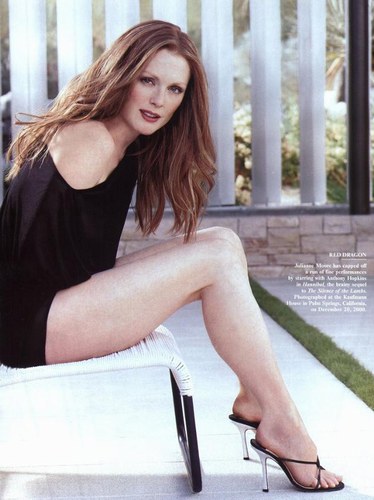
Julianne has been gracious enough to offer us, the unwashed public, a tour of her house because … well, basically because she wants to sell it.
Where did Suburban Hell come from? Why did we make it? Why do we keep making it?
Surprisingly, the answer is mostly irrational. We did it because we like farmhouses. This love of farmhouses has no utilitarian basis. It is just a fascination, the way some people like cats. The first error dates back to 1800 or so, when people began to use the farmhouse format in villages, or Small Town America. This was completely contrary to the example of Europe or Asia, where urban places always had an urban design, namely the Traditional City.
March 7, 2010: Let’s Take a Trip to Suburban Hell
July 26, 2009: Let’s Take a Trip to an American Village 3: How the Suburbs Came to Be
July 19, 2009: Let’s Take a Trip to an American Village 2: Downtown
July 12, 2009: Let’s Take a Trip to an American Village
Thus, it seems to me that part of the solution to Suburban Hell is an aesthetic solution. It is not a matter of rational problem-solving. We didn’t build Suburbia for rational problem-solving reasions. We built it because we were absolutely apeshit about farmhouses. Or, at least, we couldn’t think of anything else.
Let’s list a few things that won’t work. We can’t just complain about Suburban Hell. “There’s no there there!” We’ve been doing that for at least sixty years. We just end up still stuck in Suburban Hell, and complaining about it.
We can’t try to fix Suburban Hell with little tweaks. Like changing decorative shrubbery to edible bushes, like blueberries. Or backyard chickens. As if the problem with Suburban Hell was Not Enough Blueberries. Or adding a bike lane. Like a paint stripe is going to fix all the problems of Suburban Hell. Or even adding more apartment buildings. Then you just end up with a traffic and parking problem.
So I’m trying to change the focus here. We need to be able to start to envision what our life in the Traditional City might be like, and to be able to say, yes, let’s go that way, instead of plodding along in the Suburban Hell fashion that has been making us miserable for decades.

See what I mean by irrational?
May 23, 2010: Transitioning to the Traditional City
In other words, we need to get out of the idea that Traditional City living is some sort of sacrifice, some sort of step down, some sort of necessary compromise, and get into the idea that it’s a ton of fun. An improvement.
April 18, 2010: How to Live the Good Life in the Traditional City
December 19, 2010: Life Without Cars: 2010 Edition
In that vein, this is actually not quite such a good example. Greenwich Village is not a Traditional City environment, it is a 19th Century Hypertrophic City, with all the consequences of that, mostly unpleasant ones.
February 21, 2010: Toledo, Spain or Toledo, Ohio?
January 31, 2010: Let’s Take a Trip to New York 2: The Bad and the Ugly
January 24, 2010: Let’s Take a Trip to New York City
However, the basic format of the Greenwich Village Brownstone is actually quite close to a traditional Traditional City format, so we can use it here. Let’s see what you get for $12.5 million these days.
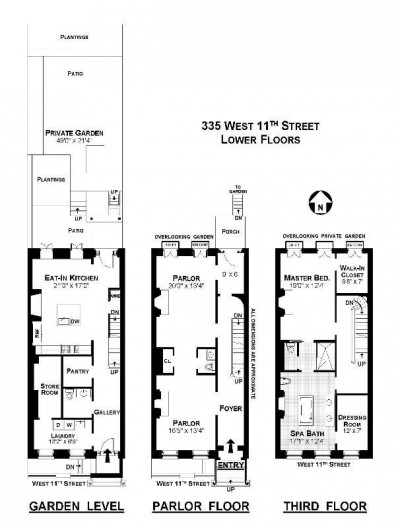
What do we see here? The land plot looks to be about twenty two feet wide. Twenty two feet! Of course the building is side-by-side with its neighbors, in the traditional Traditional City manner.
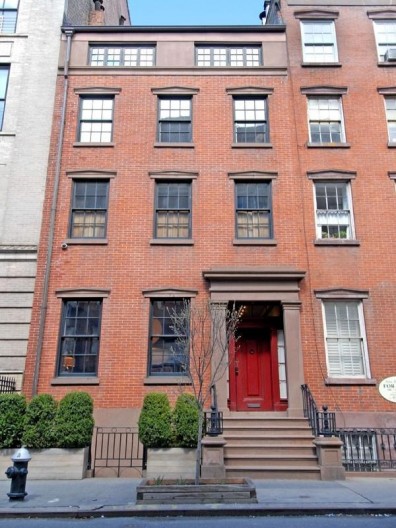
Not that impressive really.
It goes back quite a ways though, I’d guess about 100 feet although that is just an estimate. There’s a big backyard there, which actually takes up about half of the whole piece of land. This is quite luxurious, I’d say.
So, we’re talking about 2200 square feet of land here. That is one twentieth of an acre. A twentieth of an acre, in the context of Suburban Hell, is tiny. If you were to say to Mr. Suburban Hell, “you know, you could live on a twentieth of an acre, and it would be no big deal. It would be rather nice actually,” I am sure that Mr. Suburban Hell would then have an anxiety attack.
“Oh, no, that is totally unacceptable. We would be packed in like sardines! Like rats in a cage! Oh, no no no, I would rather slit my wrists than live on a twentieth of an acre.”
But, 2200 square feet, in the context of a Traditional City, is luxurious. If you were to say to Mr. Suburban Hell, “What do you think of living in Greenwich Village, in a big old brownstone with a big backyard, next door to Julianne Moore?”
Little different proposition, eh?
By the way, there are two more stories to the building:
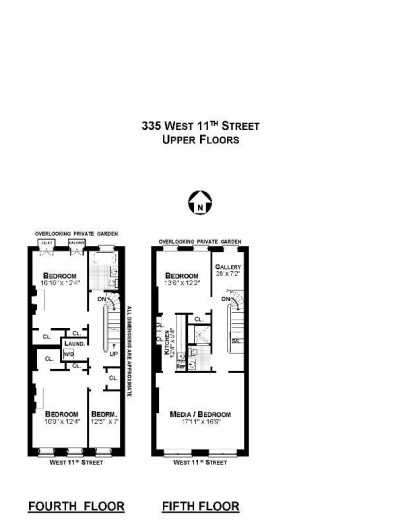
Five floors! I’d guess we’re looking at around 3500-4000 square feet here. Enough for most anyone.
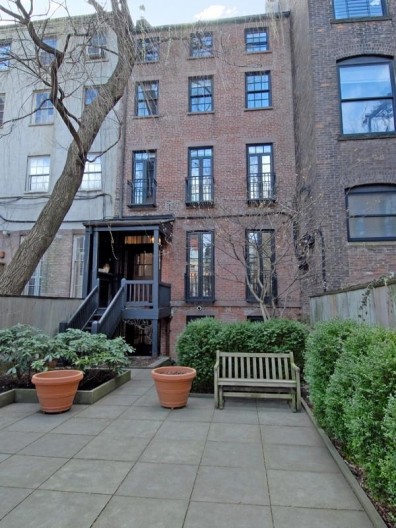
Here’s that backyard. You could do a litte more with it.
Notice what this house doesn’t have. It doesn’t have a garage! That’s because you don’t need a car. It doesn’t have any green space/landscaping. The backyard is a yard, for human use, not just a big green buffer between the living areas and the rest of Suburban Hell.
Let’s walk around inside:
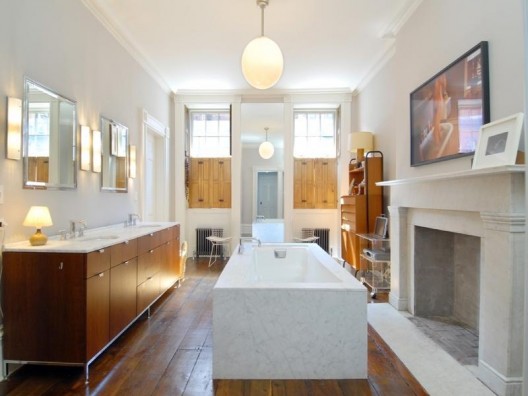
This is the bathroom.
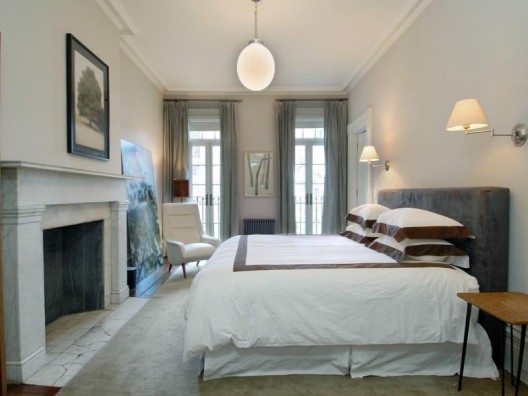
Bedroom.
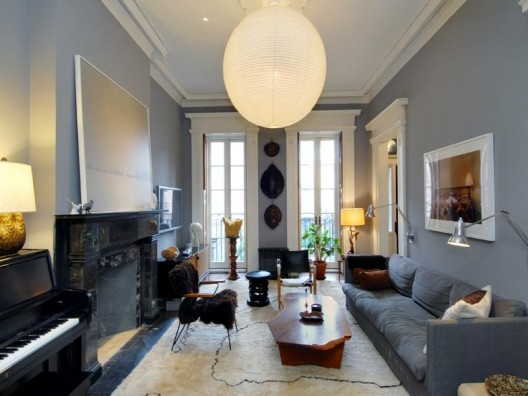
Living room.
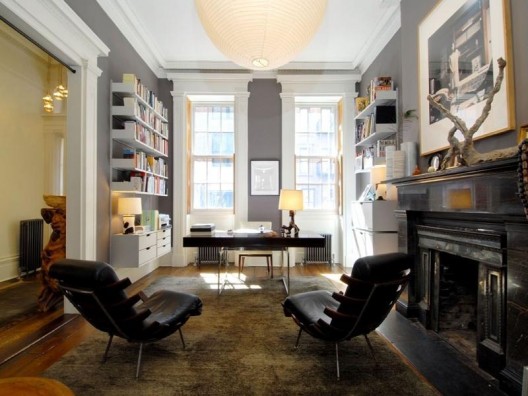
Another living room.
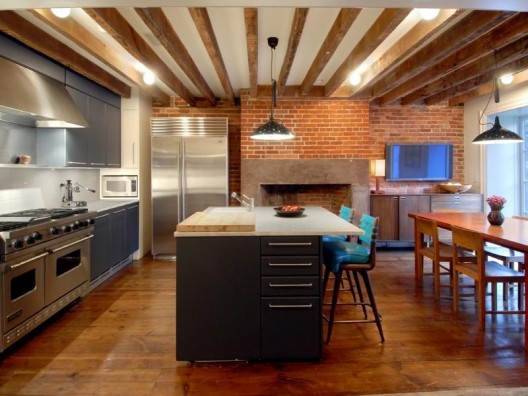
Kitchen/dining.
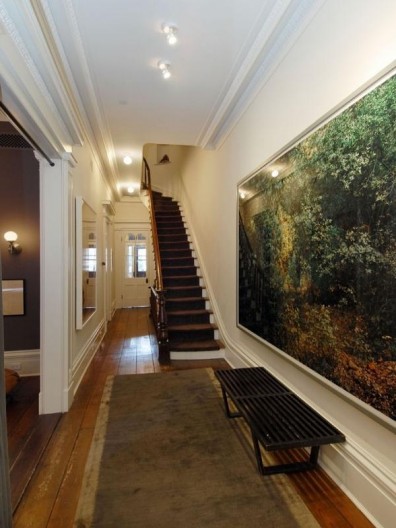
Hallway.
Not too shabby right? Do you think you could give up your Suburban Hell farmhouse fantasies and live in a place like this? I could.
I know I’m making a big sacrifice here. But I’m doing it for the planet and the future of the human race. Me and Mother Theresa, and Julianne Moore. The sackcloth and ashes club. Ha ha ha.
I mentioned that there’s no garage. No place for a car. That’s because you don’t need a car. But, you didn’t miss it did you? You didn’t say: “Well, that’s a nice place, I guess, for $12.5 million, but there’s no garage so fuggedaboutit. Maybe an A-list Hollywood actress can put up with this kind of deprivation, but it just isn’t good enough for me.”
If I was talking with Mr. Suburban Hell, and I said: “Well, you know, you could live on 2200 square feet of land, without a car, and it would be OK,” he would start getting all red in the face, and collapse on the floor trembling with spit dribbling down his chin, and I would have to call 911 because it would look like he is having a heart attack. But it would only be an anxiety attack. You have to make the mental step — it is only a mental step, there is no physical component — from the Suburban Hell picture in your head to a Traditional City picture in your head. Then, 2200 square feet with no car isn’t an unendurable hardship, it is the pinnacle of luxe.
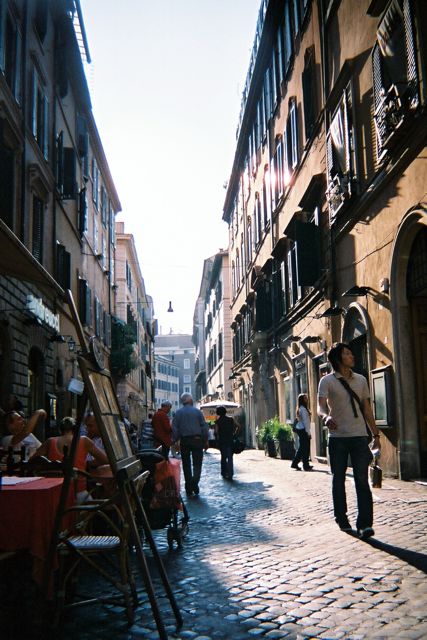
You could live in a place like this. A beautiful Traditional City environment. With your 4000sf house with a big backyard. Look at the picture. What thoughts come into your head? Is it: “Oh, that is so horrible, I definitely couldn’t do that, especially without a car,” or is it, “oooooh, looks good, gimme some of that.” See? You just don’t need a car. It becomes irrelevant. You don’t even think about it.
Now, if you’ve been following along this far, you probably noticed that a living arrangement that takes much less land area and doesn’t require a car is probably also much better for the environment. Indeed it is.
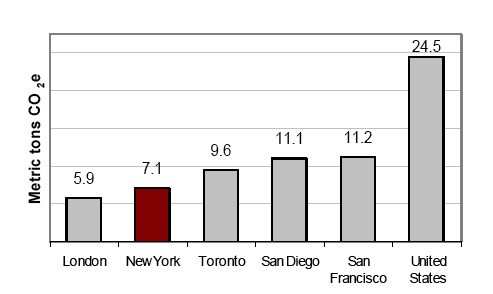
This sort of urban lifestyle consumes much less energy, here measured in metric tons of CO2. You don’t even have to think about it, it is inherent in the design.
You can just imagine what Mr. Suburban Hell’s reaction would be if I said that he could live on a twentieth of an acre, with no car, and one-fourth of the energy he is now using. But you see, these are only mental hurdles. There is no real-world, physical hurdle. In fact, Traditional City living is very comfortable and easy. I am sure that if I mentioned it in those terms, that we could have a very comfortable, modern and luxurious lifestyle with one-fourth of today’s energy usage — or even one-tenth if we actually made an effort — Mr. Suburban Hell would immediately declare it impossible. He would probably trot out all sort of arguments that such a proposition defies the laws of physics and economics. In his mind — in his mind! — if you had one-tenth the energy, then you would have an economy one-tenth the size. Of course this is nonsense. It would be the same economy, more or less, with less energy usage. In just the same way that a Prius uses one-fourth the gasoline of a Hummer, and a Loremo a tenth. It’s pretty much the same, just uses less gas. But until we get over these mental hurdles, we aren’t going to get there.
The fact that this house was built at a time (1890s perhaps) when worldwide petroleum production hadn’t even broken one million barrels a day, compared to 82 million b/d today, and when automobiles were novelty toys for the wealthy, doesn’t even cross his mind.
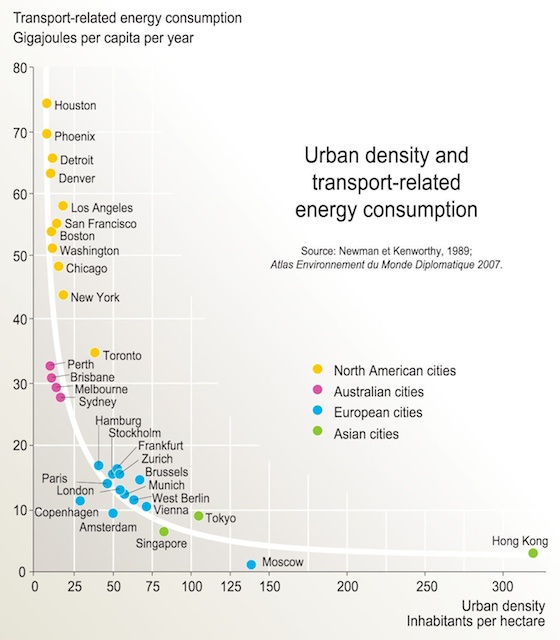
Trains are much more efficient than automobiles.
Along with Mr. Suburban Hell’s farmhouse fantasies, and the consequent automobile dependency, strip-mall horror and accompanying eco-disaster, we’ve had a counter-discussion among the Sustainability Types. The funny thing, though, is that the Sustainability Types also get an anxiety attack when we take a tour of Julianne Moore’s house. Consider how weird that is. Mr. Suburban Hell and Mr. Granola Biofuel are both on the floor writhing around. Why? Not because JM has bad taste in interior decorating. Rather, because they are struggling with their mental hurdles, the cognitive dissonance between the successful reality of the Traditional City and the various images in their minds.
Let’s see what Mr. Granola Biofuel has to say.
Me: “Well, you could live in a place like this — you have to admit it is nice — and have a big yard to indulge your tomato-growing fetishes, and it only takes a twentieth of an acre! And this lifestyle consumes only one-fourth of the energy. Even one tenth for a guy like you who goes for the whole low-flow-showerhead thing. And no cars!”
You would think that Mr. Granola Biofuel would get a little excited about that. Nope.
“You don’t understand,” he says, like he understands and I don’t. “Cities aren’t sustainable. There’s no place to graze goats!” Then I’m sure he would go on and on about Peak Oil and Limits To Growth for some interminable period, naturally oblivious to the fact that this house was built in a time when the primary use of petroleum was to provide an alternative to whale oil for lanterns, and that the Traditional City format has been sustained in Europe and Asia for only about 5000 years now. The fact that the bathtub is hewn from a single piece of Italian marble probably doesn’t go over real well either. “This is an orgy of consumption. We need to reduce, reuse, recycle!” He doesn’t notice that a solid marble bathtub doesn’t actually consume any energy. It’s just a piece of rock. You could (re)use it for a thousand years. Admittedly, it is a luxury item, not really suitable for the entire population, but there isn’t anything unsustainable about it. It is a piece of rock! You can’t get much more sustainable than a piece of rock. The fact that his little-teeny farm fantasy, of twenty acres in the woods, isn’t really applicable to an entire population either doesn’t quite register. Twenty acres of land is much bigger than a bathtub. Has a lot more rock too.
If Mr. Granola Biofuel happend to find a 165-year-old solid marble bathtub at a garage sale for $75, you can be sure he would buy it and then go on and on about how it suits his eco-lifestyle to wash his butt in this beautiful piece of vintage old-world craftsmanship rather than some cheapie Chinese junk from Home Depot. In other words, the basic problem is that, unlike Julianne Moore, he doesn’t have $11,199 to spend on a bathtub. Well, that’s OK, but spare me the speechifying. What a bonehead.
At the end of the day, the problem with Mr. Granola Biofuel is that the 4000sf Greenwich Village Brownstone doesn’t match his mental picture, of a little self-sufficient micro-farm. All of Mr. Granola Biofuel’s talk talk talk really amounts to irrational justification of an irrational goal, this mini-farm fantasy.
April 19, 2009: Let’s Kick Around the “Sustainability” Types
April 4, 2010: The Problem With Little Teeny Farms 2: How Many Acres Can Sustain a Family?
March 28, 2010: The Problem With Little Teeny Farms
The fact of the matter is, Mr. Suburban Hell’s mental picture and Mr. Granola Biofuel’s mental picture is the same mental picture. Mr. Suburban Hell has a picture of a big farm with a big house, and Mr. Granola Biofuel has a picture of a small farm with a small house. It is the rich guy version and the average guy version of the same thing!
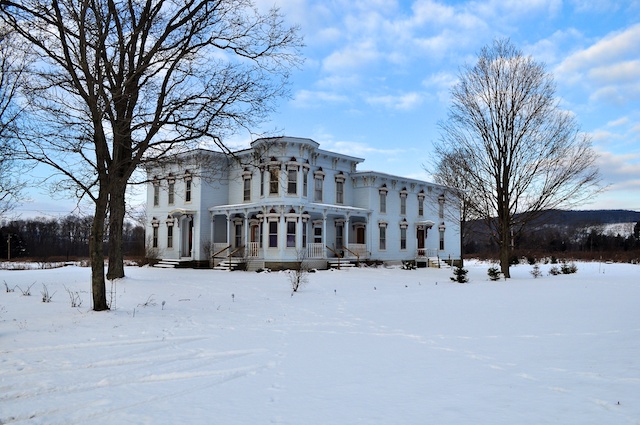
This is a farmhouse from the 1890s, in a lovely Italianate style. Upstate NY. See all the open land around? That is the farm. It was originally several hundred acres in size. This is not in a village. It is really a real farmhouse, rich guy style. Quite fantastic you must admit. But you can’t make a city from it. This is the picture in Mr. Suburban Hell’s mind. If you look at the most expensive Suburban homes, the ones on four acres, they look something like this, no?
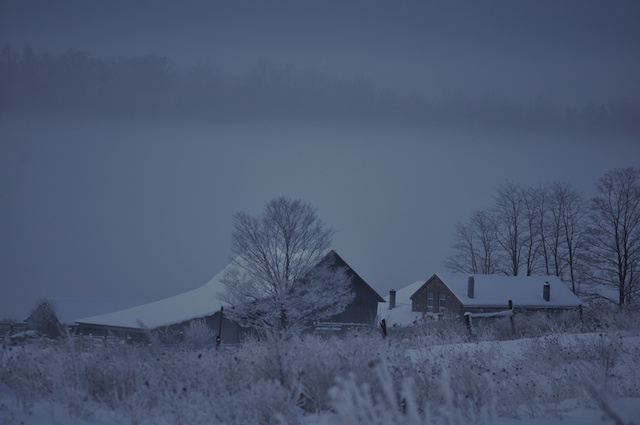
This is a more modest farmhouse, probably also dating from the 1880s-1890s. Yes, it is a real farmhouse, with a farm all around. This is the picture in Mr. Granola Biofuel’s mind.
Until we replace this picture with a picture that is appropriate for an urban environment, we will encounter endless difficulties.
Of course, our 4000sf townhouse is an example of a rather upscale residence. Just the construction costs alone on something like this would run around $600,000, possibly more. ($150 per square foot, considering the high level of craftsmanship, times 4000 sf.) Not really affordable by the majority of people. But, you could live in an apartment, consisting of one floor (about 800sf) in a building like this. Then, the cost would be more like $600,000/five floors = $120,000. We would have all the advantages of this sort of lifestyle, without the big property taxes and big mortgage. And, we would have five households on a twentieth of an acre, not just one. You could even use that backyard space for another (or larger) building, and thus get ten households on your twentieth of an acre — without a highrise building, just a nice five-story apartment building. Then you wouldn’t have your own backyard, but you could walk to the neighborhood park. It would be fine.
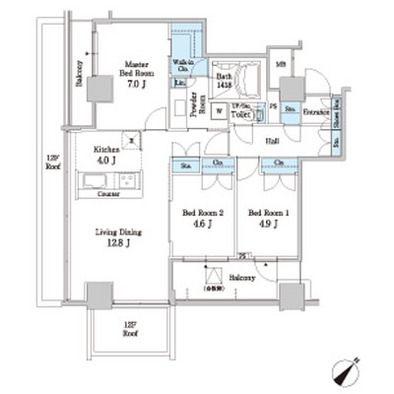
822 square foot, three bedroom apartment, with two balconies, walk-in closet, and three-part bathroom/toilet.

The snowy Japanese village of Nozawa Onsen. The building on the right is a hotel, but it could just as well be an apartment building. Could you live in a place like this? Sure — especially considering that one of Japan’s best ski areas is about a hundred yards away (the green astroturf is so you can walk to the lifts from the hotel with your boots on). The Traditional City doesn’t require any hardship or sacrifice or expense. You just have to say: “yes, I like that.”
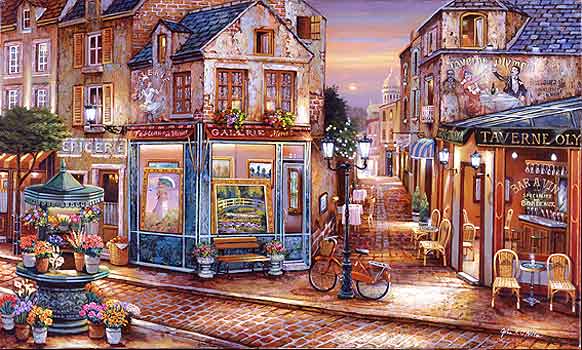
Doesn’t that look like fun? Are you ready to give up your Suburban Hell little farmhouse fantasies? Both the rich guy version and the average-guy version?

Thanks for showing us around Julianne!

“Thanks for stopping by!”
Other commentary in this series:
February 13, 2011: Let’s Take a Traditional City Break 2: More Really Narrow Streets Than You Can Shake a Stick At
February 6, 2011: Let’s Take a Traditional City Break
December 19, 2010: Life Without Cars: 2010 Edition
October 17, 2010: The Problem of Scarcity 3: Resource Scarcity
August 22, 2010: How to Make a Pile of Dough with the Traditional City
August 1, 2010: The Problem With Bicycles
June 6, 2010: Transitioning to the Traditional City 2: Pooh-poohing the Naysayers
May 23, 2010: Transitioning to the Traditional City
May 16, 2010: The Service Economy
April 18, 2010: How to Live the Good Life in the Traditional City
April 4, 2010: The Problem With Little Teeny Farms 2: How Many Acres Can Sustain a Family?
March 28, 2010: The Problem With Little Teeny Farms
March 14, 2010: The Traditional City: Bringing It All Together
March 7, 2010: Let’s Take a Trip to Suburban Hell
February 21, 2010: Toledo, Spain or Toledo, Ohio?
January 31, 2010: Let’s Take a Trip to New York 2: The Bad and the Ugly
January 24, 2010: Let’s Take a Trip to New York City
January 10, 2010: We Could All Be Wizards
December 27, 2009: What a Real Train System Looks Like
December 13, 2009: Life Without Cars: 2009 Edition
November 22, 2009: What Comes After Heroic Materialism?
November 15, 2009: Let’s Kick Around Carfree.com
November 8, 2009: The Future Stinks
October 18, 2009: Let’s Take Another Trip to Venice
October 10, 2009: Place and Non-Place
September 28, 2009: Let’s Take a Trip to Barcelona
September 20, 2009: The Problem of Scarcity 2: It’s All In Your Head
September 13, 2009: The Problem of Scarcity
July 26, 2009: Let’s Take a Trip to an American Village 3: How the Suburbs Came to Be
July 19, 2009: Let’s Take a Trip to an American Village 2: Downtown
July 12, 2009: Let’s Take a Trip to an American Village
May 3, 2009: A Bazillion Windmills
April 19, 2009: Let’s Kick Around the “Sustainability” Types
March 3, 2009: Let’s Visit Some More Villages
February 15, 2009: Let’s Take a Trip to the French Village
February 1, 2009: Let’s Take a Trip to the English Village
January 25, 2009: How to Buy Gold on the Comex (scroll down)
January 4, 2009: Currency Management for Little Countries (scroll down)
December 28, 2008: Currencies are Causes, not Effects (scroll down)
December 21, 2008: Life Without Cars
August 10, 2008: Visions of Future Cities
July 20, 2008: The Traditional City vs. the “Radiant City”
December 2, 2007: Let’s Take a Trip to Tokyo
October 7, 2007: Let’s Take a Trip to Venice
June 17, 2007: Recipe for Florence
July 9, 2007: No Growth Economics
March 26, 2006: The Eco-Metropolis

